[/caption]
At last, NASA embraces a romantic rendezvous in the dark void of deep space.
And soon the whole world can watch the up close meet up of the hot Stardust probe and the volatile, icy comet. The historic space tryst is less than a day away!
The Stardust-NExT spacecraft successfully hot fired its thrusters for the final course correction maneuver (TCM-33) on Feb. 12, setting up the fleeting celestial encounter with Comet Tempel 1 on Valentine’s Day, Feb. 14, Monday, at 11:37 p.m. EST. The space science probe will fly by the speeding comet at a distance of approximately 200 kilometers (124 miles) and at a speed of 10 km/sec.
Naturally, the fleeing comet is icy, unpredictable and exploding with jets of gas and dust particles. So there is some uncertainly at NASA and amongst the science team as to what we’ll actually see when the cameras unveil the hidden secrets of the nucleus of Temple 1.
The encounter phase has begun now (Feb. 13) at 24 hours prior to closest approach (Feb. 14) and concludes 24 hours after closest approach.
“The final TCM burn on Feb. 12 went well,” JPL spokesman DC Agle told me today (Feb.13)
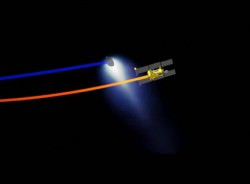 It’s been a long wait and a far flung journey. Stardust has cruised some 6 Billion kilometers through our solar system – looping several times around the sun over a dozen years and is now nearly bereft of fuel.
It’s been a long wait and a far flung journey. Stardust has cruised some 6 Billion kilometers through our solar system – looping several times around the sun over a dozen years and is now nearly bereft of fuel.
For three and a half long years, the anticipation has been building since NASA approved the repurposing of the Stardust spacecraft in 2007 and fired the thrusters to alter the probes trajectory to Comet Temple 1 for this bonus extended mission.
But until the photos are transmitted across 300 million kilometers of space back to Earth, we won’t know which face of the comets surface was turned towards the camera as the curtain pulls back for the revealing glimpse.
Everything hinges on how accurately the mission team aims the reliable probe and the finicky rotation of the changeable comet.
The irregularly shaped nucleus of Tempel 1 measures barely 5 to 8 km in diameter.
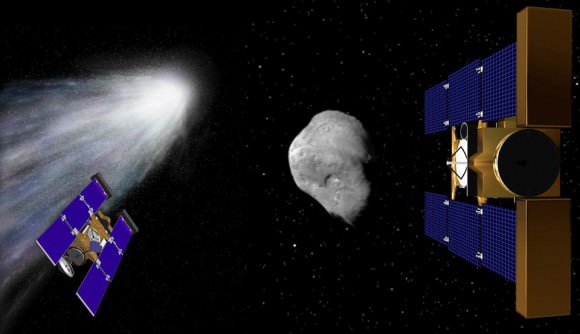
Stardust-NExT makes history on Valentine’s Day - February, 14, 2011
Tempel 1 is the first comet to be visited twice by spacecraft from Earth. Stardust will have visited 2 comets and gathered science data: Comet Wild 2 in 2004 (left) and Comet Tempel 1 in 2011 (right).
Artist renderings Credit: NASA. Collage: Ken Kremer.
The Feb. 14 encounter marks the first time in history that a comet has been visited twice by spaceships from Earth. The revisit provides the first opportunity for up-close observations of a comet both before and after a single orbital pass around the sun.
In July 2005, NASA’s Deep Impact probe delivered a 375 kg projectile that penetrated at high speed directly into the comets nucleus. The blast created an impact crater and ejected an enormous cloud of debris that was studied by the Deep Impact spacecraft as well as an armada of orbiting and ground based telescopes.
Somewhat unexpectedly, the new crater was totally obscured from the cameras view by light reflecting off the dust cloud.
“The primary goal is to find out how much the comet’s surface has changed between two close passages to the sun since it was last visited in 2005,” says Joe Ververka of Cornell University, who is the principal investigator of the Stardust-NExT mission.
This time around, researchers hope to determine the size of the crater. Numerous bets hinge on that determination.
It’s also quite possible that the crater itself has significantly changed in the intervening five and one half years as the Jupiter-class comet orbits between Mars and Jupiter.
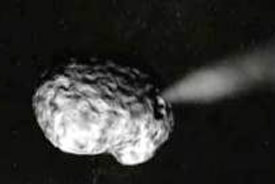 “Comets rarely behave,” says Tim Larson, the Stardust-NExT mission project manager from the Jet Propulsion Laboratory (JPL), Pasadena, Calif.
“Comets rarely behave,” says Tim Larson, the Stardust-NExT mission project manager from the Jet Propulsion Laboratory (JPL), Pasadena, Calif.
“Temple 1 exhibits a complex rotation. The rotation period is about 41 hours. But the trajectory changes due to the comet jets and activity.”
“Ideally we would like to obtain photos of old and new territory and the crater from the Deep Impact encounter in 2005,” Larson explained.
“Tempel 1 is the most observed comet in history using telescopes worldwide as well as the Hubble and Spitzer Space Telescopes.”
Engineers are using all this data to fine tune the aim of the craft and get a handle on which sides of the comet will be imaged. But either way the team will be elated with the science results regardless of whether the images reveal previously seen or new terrain.
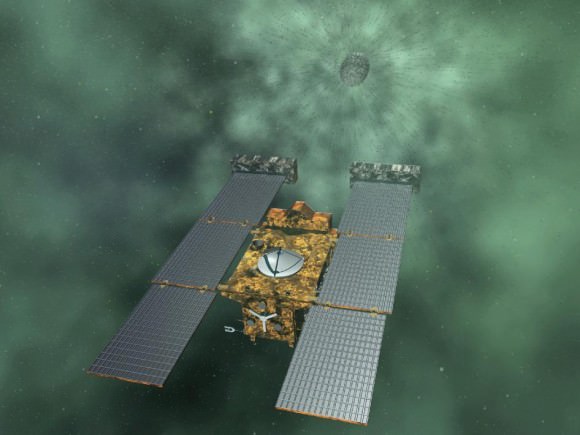
Artist concept of NASA's Stardust-NExT mission, which will fly by Comet Tempel 1 on Feb. 14, 2011. Credit: NASA/JPL-Caltech/LMSS
Today, Feb. 13, mission controllers at JPL are uplinking the final flyby sequences and parameters for Monday’s (Feb. 14) historic encounter.
Stardust-NExT will take 72 high resolution images of Comet Tempel 1 during the close approach. The team expects the nucleus to be resolved in several of the closest images. These will be stored in an onboard computer and relayed back to Earth starting about three hours later.
“All data from the flyby (including the images and science data obtained by the spacecraft’s two onboard dust experiments) are expected to take about 10 hours to reach the ground,” according to a NASA statement.
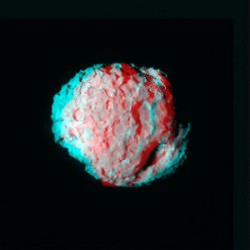
Stardust continued its solitary voyage through the void of the space. Until now !
Watch the Stardust-NExT Romantic Rendezvous: Live on NASA TV
NASA has scheduled live mission commentary of the flyby and a post encounter news briefing on Feb. 14 and Feb. 15. These will be televised on NASA TV as follows:
February 14, Monday
11:30 p.m. – 1 a.m. (Feb. 15) – Live Stardust-NExT Mission Commentary (including coverage of closest approach to Comet Tempel 1 and re-establishment of contact with the spacecraft following the encounter) – JPL
February 15, Tuesday
3 – 4:30 a.m. Live Stardust-NExT Mission Commentary (resumes with the arrival of the first close-approach images of Comet Tempel 1) – JPL
1 p.m. – Stardust-NExT Post-Encounter News Briefing – JPL
Five facts you should know about NASA’s Stardust-NExT spacecraft as it prepares for a Valentine’s “date” with comet Tempel 1. From a NASA Press Release
1. “The Way You Look Tonight” – The spacecraft is on a course to fly by comet Tempel 1 on Feb. 14 at about 8:37 p.m. PST (11:37 p.m. EST) — Valentine’s Day. Time of closest approach to Tempel 1 is significant because of the comet’s rotation. We won’t know until images are returned which face the comet has shown to the camera.
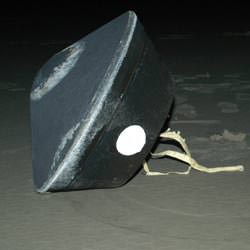
3. “The First Time Ever I Saw Your Face” – The Stardust-NExT mission will allow scientists for the first time to look for changes on a comet’s surface that occurred after one orbit around the sun. Tempel 1 was observed in 2005 by NASA’s Deep Impact mission, which put an impactor on a collision course with the comet. Stardust-NExT might get a glimpse of the crater left behind, but if not, the comet would provide scientists with previously unseen areas for study. In addition, the Stardust-NExT encounter might reveal changes to Tempel 1 between Deep Impact and Stardust-Next, since the comet has completed an orbit around the sun.
4. “The Wind Beneath My Wings” – This Tempel 1 flyby will write the final chapter of the spacecraft’s success story. The aging spacecraft approached 12 years of space travel on Feb. 7, logging almost 6 billion kilometers (3.5 billion miles) since launch. The spacecraft is nearly out of fuel. The Tempel 1 flyby and return of images are expected to consume the remaining fuel.
5. “Love is Now the Stardust of Yesterday” – Although the spacecraft itself will no longer be active after the flyby, the data collected by the Stardust-NExT mission will provide comet scientists with years of data to study how comets formed and evolved.
Do you know the artists names who wrote and sing these celestially romantic tunes ?
NASA Stardust NExT Video: Date with a Comet – Tempel 1
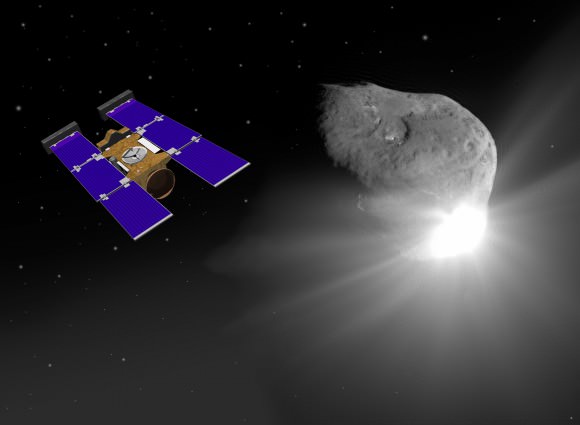
Artist rendering of upcoming flyby on February, 14, 2011. Credit: NASA
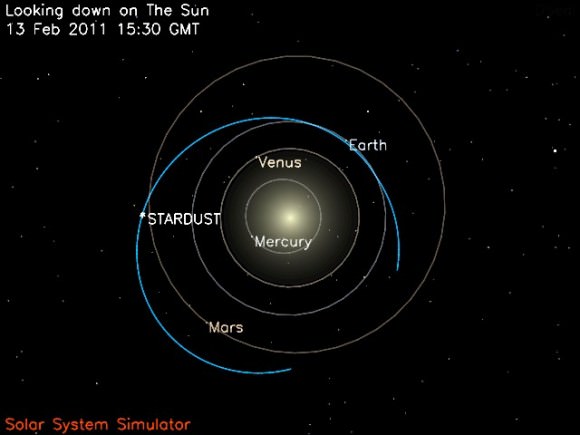
Looking Down on the Sun. This image shows the current position of the STARDUST spacecraft and the spacecraft's trajectory (in blue) around the Sun. Credit: NASA
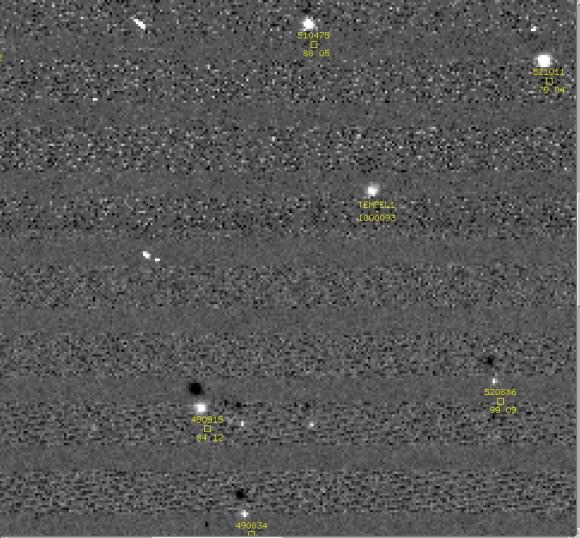
Taken by Stardust-NExT at about 10:30 a.m. on Feb. 11 – newly obtained from JPL. This region is about 1.2 degrees on a side - 351 x 351 pixels. Exposure duration 10 seconds. These images are crucial for precisely aiming Stardust-NExT. Credit: NASA/JPL
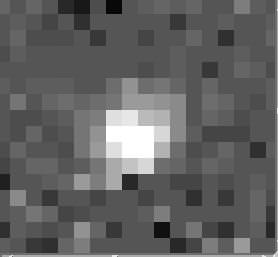

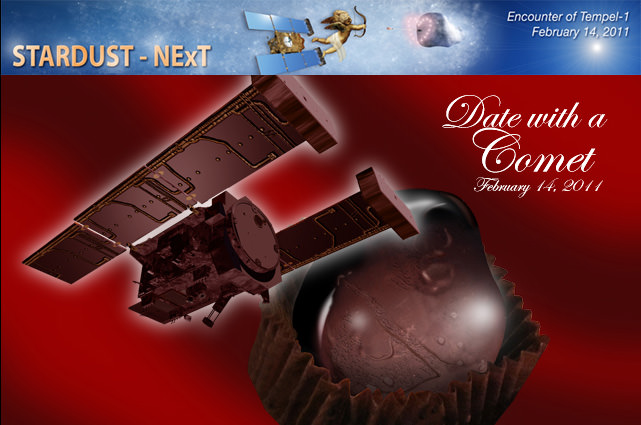


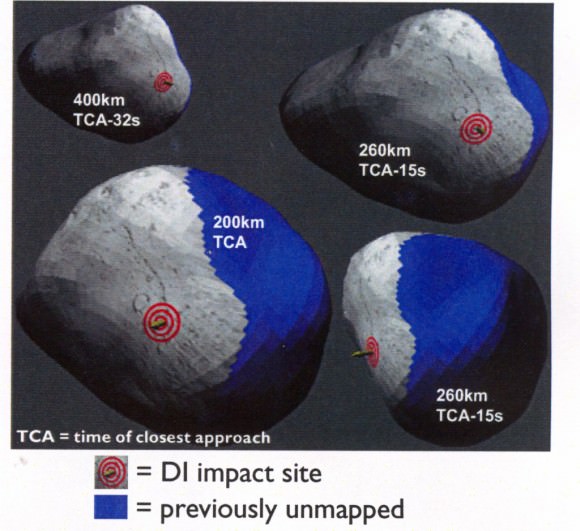
What is EST?
Eastern Standard Time. New York.
So it’s 8:37 PM EST or is it really EDT, which is what we’re really on?
Why don’t people just use ET and leave it to us to know whether it’s daylight or standard time? Everybody’s so used to letting Eastern Standard Time roll off the tongue that they no longer think what it means.
Oops. Never mind. Don’t know what I was thinking. We’re on Standard Time.
;-(
I’m anxious to see the first images that the probe sends back, can’t wait to see if the crater made by Deep Impact has been imaged!
I’ll be waiting with chocolate-bated breath!
Anyone know when the images are going to be released?